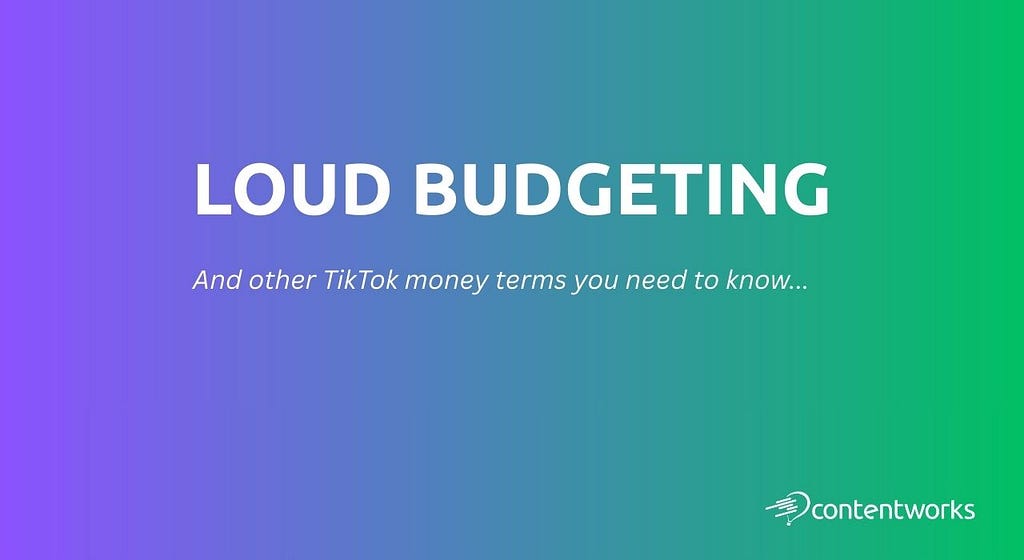Communication
As Europe’s leading communication agency, we’re a front runner in content marketing, messaging, PR and crisis management. Check out our guides, roundups and brand fails.
Finance
Contentworks is Europe’s favourite marketing agency for fintech, finance, banking, regulations roundups, technical analysis and much more. Here’s our finance hub.
In The Media
Contentworks Agency regularly publishes insights, interviews and opinions in leading finance, business and communication sites around the world. You can read our latest PRs and media appearances here.
Tech
Read the latest articles on blockchain, AR, AI and metaverse and all things tech from our team.
Company News
Keep up with the latest news and awards from the Contentworks team. Ok maybe not the awards part.
Events
From champagne filled launch parties to conferences, webinars and expos. If it’s finance we can cover it. Send us your finance event and we may feature it here.
Contentworks on Medium
Bear markets, oil, market news and FX conspiracy theories! Check out our bitesize financial articles published weekly on our Medium channel.
Stories by Contentworks Agency on Medium Stories by Contentworks Agency on Medium
- Sleigh Bells and Stock Gains. Is the Santa Claus Rally Coming to Town?by Contentworks Agency on December 8, 2025 at 7:29 am
As December arrives, investors and traders begin preparing for two things: year-end portfolio checks and the familiar debate about the Santa Rally. Is it myth? Is it math? And most importantly, is it likely to appear this year? While reindeer sightings remain unproven, the numbers behind the Santa Rally are very real. Let’s unwrap the data.What Exactly Is the Santa Claus Rally?The Santa Claus Rally refers to a seven-day period that includes the last five trading sessions of December and the first two of January. During this window, equities have historically shown a tendency to rise. Several factors may contribute to this effect such as reduced trading volume, positive investor sentiment, tax-related positioning and institutional window dressing.A Look at the HistoryHere’s what the past seven decades of market behaviour reveal:Since 1950, the S&P 500 has generated gains during the Santa Rally period about 76% of the time.The average increase over these seven sessions is about 1.3%.Historically, this period has outperformed a typical random seven-day stretch.When the Santa Rally fails to appear, the following year has sometimes delivered weaker market performance. This makes the pattern a useful sentiment indicator.FX markets also display seasonal tendencies.Commodity currencies such as AUD, NZD and CAD often benefit from risk-on flows during the holiday period.USD liquidity typically tightens as institutions close out the year, which can generate price swings across major pairs.Reasons Santa Might Visit in 2025Several conditions may support a positive year-end environment for risk assets.#1 Reduced December VolatilityVolatility often fades during late December as institutional desks wind down and market participants take holiday leave.The VIX has historically traded below its annual average during this period.Lower volatility can encourage risk-taking in both equities and higher beta FX pairs.With reduced market participation, even modest buying pressure can lift indices more easily than during busier periods.For brokers and asset managers, thinner markets may create short bursts of momentum that, while attractive, require caution and tighter execution discipline.#2 Institutional Rebalancing and Window DressingPortfolio rebalancing is a significant driver of year-end flows.Pension funds and large institutions adjust holdings to match target allocations which can include increasing exposure to equities if stocks underperformed relative to bonds earlier in the year.Fund managers often prefer to showcase well-performing assets in their year-end reporting, a behaviour known as window dressing.These flows can create upward pressure on blue-chip and high-performing sectors with strong full-year metrics.Such positioning tends to support indices but can also create short-term supply and demand imbalances that FX traders track closely, especially in pairs sensitive to equity sentiment such as GBP/JPY and AUD/JPY.#3 Robust Holiday Spending and Earnings ExpectationsHoliday consumer activity plays a major role in shaping market mood.Strong retail and ecommerce data often provide early signals of Q4 earnings performance.Retail giants and tech firms with exposure to consumer discretionary spending sometimes benefit from this optimism.In years where employment remains strong and consumer balance sheets are healthy, year-end sentiment typically improves, supporting equity indices.This momentum spills over into FX markets where currencies linked to consumer-driven economies, such as USD and GBP, may react to spending and inflation expectations.#4 Central Bank Signalling and Liquidity DynamicsDecember policy meetings can set the tone for markets heading into January.A pause or dovish tone from the Federal Reserve or European Central Bank can lift risk appetite and weaken the US dollar.Conversely, tighter guidance may temporarily suppress the seasonal rally but can also generate trading opportunities across rate-sensitive assets.Liquidity provided or withdrawn by central banks affects year-end treasury markets which in turn influence FX flows and equity valuations.Investors and brokers watch these meetings carefully, as even small changes in projections or dot plots can determine whether seasonal optimism gains traction.Why Santa Might Skip a Stop This YearEven during a festive season, several factors can interfere with the pattern:Geopolitical uncertaintyPersistent inflation or surprisingly hawkish central bank messagingLow liquidity that amplifies downward moves rather than upward onesHeavy tax-loss harvesting by investorsIn these situations, markets can become more reactive than cheerful and the Santa Rally may fail to appear.Key Indicators for Traders and Decision MakersInvestors should watch for:Early December equity performance. Weakness in the first half of the month sometimes precedes a stronger rally later.Treasury yield movements. Lower yields often support equities.USD direction. A softer dollar frequently aligns with a traditional Santa Rally.Sector leadership patterns. Technology and consumer discretionary sectors often shine during seasonal upswings.At Contentworks, our financial writers are following global market developments, policy signals and cross-asset flows closely and we continue producing actionable insights for our clients throughout the holiday period.Will Santa’s Sleigh Be Fully Stocked?Historical trends suggest that Santa usually pays a visit. However, the 2025 market environment remains shaped by inflation cycles, interest rate adjustments and geopolitical events. The Santa Rally may glide in with its typical seasonal momentum, or it may face pockets of turbulence.Regardless of the outcome, year-end liquidity and sentiment shifts create meaningful opportunities for well-prepared traders and decision makers. Keep your charts open, your risk management disciplined and your festive optimism intact. The holidays may bring joy, but the financial markets never truly switch off.Want financial marketing for your broker, bank or fintech? Book a free call with our team.
- Gobbles, Gains and the Markets, A Thanksgiving Specialby Contentworks Agency on November 17, 2025 at 5:50 am
As families gather, turkeys take centre stage and traders quietly eye the screens, Thanksgiving brings a curious blend of feast, travel and some market quirks. Grab your pecan pie and let’s explore how the financial markets behave around Thanksgiving, why it matters for traders, and the lighter side of “markets taking a mini-vacation”.Market Moves Around ThanksgivingMarkets in the U.S. are closed on Thanksgiving Day and have a short trading day the following Friday.Historically, the S&P 500 tends to post positive returns during Thanksgiving week. Going back to 1928, the S&P rose about 60% of the time during that week, with an average return around +0.28% (median +0.46%).In U.S. presidential election years, the odds improve. About 75% of the time the S&P posts a gain during Thanksgiving week, with an average return closer to +0.88%.A more detailed study shows the days just before and just after Thanksgiving tend to show better strength (and lower volatility). Though the effect isn’t huge and the variability is large.One interesting trading strategy study found that going long from the close the Monday of Thanksgiving week and exiting around the first trading day of December showed an average gain of 0.51% with an 80% win ratio (for a specific retail-sector focused set) over many years.Why Does This Happen?Shortened week, lighter volume: With traders taking time off, some believe fewer participants and lighter volume can amplify modest moves.Holiday optimism: The mood shifts toward consumer spending, more retail activity (especially with the upcoming Black Friday) and expectation of strong seasonality in consumption. This can boost sentiment.Seasonal positioning: Some institutional investors may wrap up positions or reduce risk ahead of the holiday lull, influencing flows.“Take-the-money and go” mood: With many taking time off, some traders may close or reduce positions, which can reduce drag or volatility.Retail stocks in focus: Because consumer behaviour comes into sharper focus around Thanksgiving/Black Friday, retail and consumer stocks often draw attention.Traders, Vacations & Turkey — Some Fun FactsMany traders plan their mini-vacation around this week so think fewer meetings and a lighter calendar. Some desks effectively wind down early.According to one report, nearly 80 million Americans travel during Thanksgiving holiday periods. That’s a lot of empty desks and fewer emails.Some trading desks treat the week like a “half-rally, half-holiday” monitoring markets, but also squeezing in some pumpkin-pie time.It’s a curious psychological moment: markets calm and “holiday spirit” may seep in, sometimes translating into gentler risk-on moves.One quirk: The day before Thanksgiving (often a half-day for many offices) tends to show one of the stronger daily performances of the week. Traders may want to rotate for early exits.As of November 2023, “US airline stocks have rebounded as Thanksgiving travel ramps up with a record 30 million people expected to take to the skies over the holiday period.” For example, the shares of United Airlines Holdings Inc. (UAL) gained approx. 16.7% in the month leading up to the holiday from one point in time.In 2024 amid the Thanksgiving travel-period, stocks of Expedia Group, Inc. (EXPE) rose 2.8% and Booking Holdings Inc. (BKNG) 1.6% in response to stronger travel demand.What Should Financial Marketers Think About?If you work in financial services marketing, Thanksgiving week is a great “hook period”. Craft content around: “What the holiday-week market behaviour tells us”, “Why traders are watching consumer stocks now”, or “5 things investors can do during lighter volume weeks”.With many traders and clients off for the holiday, news may travel more slowly, consider when you issue investor updates or press releases (e.g., early in the week before people sign off).Take time to wish your clients a Happy Thanksgiving whether that’s by email or via social media.Wishing You a Prosperous and Peaceful ThanksgivingAs we head into the holiday, we’d like to take a moment to thank our US clients and partners for your continued trust and collaboration throughout the year.Please note that U.S. financial markets will be closed on Thursday, November 27, for Thanksgiving Day, and will reopen for a shortened trading session on Friday, November 28, closing at 1:00 p.m. ET.Whether you’re analysing markets, carving the turkey, or simply enjoying time with family, we wish you a Happy Thanksgiving filled with gratitude, good company, and maybe even a little market cheer.
- The October Effect, Fact or Spooky Superstition?by Contentworks Agency on October 7, 2025 at 4:37 am
It’s that time of year again. Pumpkin spice lattes, fake cobwebs, and spooky stories. We love it, but for traders and investors, October brings a chill of a different kind. Yep, it’s the infamous “October Effect.” Legend has it that markets are cursed in October, a month haunted by crashes, corrections, and investor panic. But is the October Effect a genuine financial phenomenon, or just a superstition that refuses to die? Let’s channel our inner Jessica Fletcher and shine a flashlight into the shadows of market history.The Origins of the October EffectThe “October Effect” is a long-standing market superstition suggesting that stock prices tend to fall during October. This belief has persisted for over a century, largely because some of the most dramatic market crashes in history occurred in this seemingly cursed month.A few spine-chilling examplesOctober 1907 — The Panic of 1907: A run on banks and trust companies triggered a market collapse of nearly 50%, forcing financier J.P. Morgan to personally step in and restore confidence.October 1929 — The Wall Street Crash: The granddaddy of all financial nightmares. On October 24 and 29, U.S. stocks plunged nearly 25% in just two trading days, ushering in the Great Depression.October 1987 — Black Monday: The Dow Jones Industrial Average fell a terrifying 22.6% in a single day, still the largest one-day percentage drop in U.S. market history.October 2008 Global Financial Crisis: As the housing bubble burst, the Dow dropped 1,874 points in a single week, marking one of the darkest periods of the 21st century for investors.With a track record like that, it’s no wonder October has earned its spooky reputation.So, Is The October Effect Real?Here’s where the data tells a different story. Despite the October Effect’s eerie lore, there’s no statistical evidence that October is consistently worse for markets.According to LPL Financial’s 2023 data, the S&P 500 has averaged a 0.9% gain in October since 1950 making it the seventh-best month of the year for performance. Similarly, Dow Jones historical data shows that October often marks the end of bear markets rather than their start. For example, recoveries began in October 2002, 2011, and 2022.So, while October may host a few spectacular market scares, on average, it’s no more dangerous than any other month. In fact, it often brings opportunity for savvy investors who don’t spook easily.Why the Fear PersistsThe persistence of the October Effect is partly psychological. Behavioural finance explains that humans are pattern-seeking creatures. We connect emotionally charged events (like market crashes) and assume they’re linked. Combine that with the media’s love for dramatic headlines like “October Panic Returns!” and you’ve got the perfect recipe for seasonal market anxiety.It’s also worth noting that volatility often spikes in the final quarter of the year. Earnings season, mutual fund rebalancing, and geopolitical or macroeconomic shifts can all contribute to sharper market movements. But these are timing coincidences, not dark curses from beyond the trading floor.A Month for Opportunity, Not FearDespite its ghostly reputation, October has also seen plenty of positive market magic:In October 2011, the S&P 500 rallied over 10% after a tough summer.October 2022 marked the start of a powerful recovery after the inflation-driven selloff earlier that year.Historically, October often sets the stage for the “Santa Claus Rally”, where markets rise into the year-end holiday season.So perhaps October isn’t a monster at all. Just a misunderstood month with a flair for drama.Lessons for Traders and Investors· Don’t let superstition drive strategy. Market behaviour is guided by fundamentals, not folklore.· Stay diversified and data-driven. Seasonal volatility can create both risks and opportunities.· Use October wisely. It’s a great time to rebalance portfolios and look for undervalued assets heading into Q4.· Keep emotions in check. As Warren Buffett famously said, “Be fearful when others are greedy, and greedy when others are fearful.”The real fright for investors isn’t October itself. It’s reacting emotionally to market noise. While history gives the month an ominous reputation, the data proves it’s more treat than trick.With 10+ years in financial marketing we love to dispel (or confirm) market myths and superstitions. Talk to us about financial content that turns complex market stories into clear, engaging narratives. No ghosts attached. Book a free Zoom with our team.
- Loud Budgeting & Gen Z Money Slangby Contentworks Agency on September 23, 2025 at 5:56 am
For this generation, finance isn’t just about numbers, it’s about culture, language, memes, and even therapy. From loud budgeting to doom spending to cash stuffing, Gen Z has created a whole vocabulary around money that is equal parts funny, honest, and relatable. These new words aren’t just internet jokes. They capture real financial behaviours and the emotional weight of living through uncertain times. In this article we will reveal how younger people are trying to balance survival, fun, and authenticity in a world that often feels stacked against them.The Rise of Loud BudgetingThe term “loud budgeting” first went viral on TikTok in late 2023 when comedian Lukas Battle declared that “loud budgeting is in, quiet luxury is out.” The video gained more than 1.5 million views, and suddenly people were openly saying what past generations kept private.“I’m not going out tonight, my budget doesn’t allow it.”“That trip looks amazing, but I’m saving for rent instead.”Loud budgeting is about loudly owning your financial boundaries instead of quietly making excuses. It takes the shame out of saying “no,” and turns it into a statement of empowerment. Rather than pretending you’re too busy to join a fancy dinner, you can confidently say you don’t want to blow $80 on sushi when you’re trying to save for something else.https://www.tiktok.com/@jordan_the_stallion8/video/7348208986547752238This honesty is refreshing and fits a broader cultural move toward talking about mental health, therapy, and now money.· From a Bank of America / Ipsos survey of U.S. Gen Z (ages 18–27). 38% feel okay declining social events because they can’t afford them. Part of being “loud” about budgeting and financial limits.· 63% say they do not feel pressured by friends to overspend, suggesting louder, more open boundaries are helping reduce social spending pressure.· Searches for “loud budgeting” have spiked 1,637% internationally and 765% in the U.S.· A Business Insider survey indicated that one-third of Gen Zs say they are “loud budgeters,” saving an average of US$629 per month through being open about their financial boundaries with friends and family.Doom Spending, When Anxiety Hits Your WalletOn the flip side of frugality, we get “doom spending.” This phrase describes the act of buying things to cope with stress, climate anxiety, politics, or just the crushing uncertainty of the future.Think of it as retail therapy with an apocalyptic twist: “The world feels like it’s falling apart, so I might as well buy the concert tickets, the new sneakers, or that extra latte.”It’s a bit YOLO (You Only Live Once) only with your money. A McKinsey survey showed that Gen Z and millennials are more likely than older generations to engage in this behaviour, even though on average they earn and save less. It’s emotional spending, but also a way of reclaiming joy in uncertain times.· A survey by Intuit Credit Karma found that 35% of Gen Z and 43% of Millennials report “doom spending” to cope with stress about things like the economy or current events.Discover the doom spending trend on TikTok.Cash Stuffing, Old School Meets TikTokThen there’s “cash stuffing.” If this sounds like something your grandma did, that’s because it is. But now it’s trending on TikTok and Instagram.Check out this cash stuffing video by @budgetswithbethIt works like this. You withdraw your paycheck in cash, then divide it into envelopes labelled “rent,” “groceries,” “fun,” “savings,” and so on. Once an envelope is empty, that category is done for the month.Why does Gen Z love this retro strategy?It makes money feel real in a digital world, where swiping a card or tapping a phone feels abstract.It creates visible limits so when the “fun” envelope is empty, you stop.It fits perfectly into the ASMR/organisation aesthetic of TikTok videos (we do kind of love it too!)This is an interesting trend because while fintech apps promise slick dashboards, AI-powered insights, and digital wallets, the cash stuffing trend flips that on its head. Instead of trusting an algorithm to categorise transactions, Gen Z is literally stuffing envelopes with bills, a method that predates mobile banking by decades. It’s almost rebellious in its simplicity. No fees, no screens, no data collection. In a way, it’s the anti-fintech, proof that sometimes, managing money isn’t about more technology, but about stripping it away. It may also reflect a lack of trust in the banking sector, something we frequently talk about.Soft Savings, Balance Over AusterityAnother trending phrase is “soft savings.” Unlike hardcore savings challenges that cut out all extras, soft savings are about balance. You build a cushion but still allow yourself little joys.For example, a worker might set aside money for rent and an emergency fund, but still budget for bubble tea or a weekend trip. It’s a way of saying: “I want to be responsible, but I don’t want to feel like I’m punishing myself for being young.” This mindset reflects a shift. Financial wellness isn’t just about maximising the bank balance. It’s about creating a lifestyle that feels sustainable, mentally and emotionally.· A Harvard Public Opinion Project survey found that more than 40% of young Americans say they are “barely getting by” financially, while just 16% feel they are doing well or very well.· 73% of Gen Zs said they would rather prioritise quality of life now rather than focus on aggressively saving more money.· Also from that study, 84% of Gen Z report setting aside some portion of each paycheck into savings.Money Dysmorphia, The Social Media EffectFinally, there’s “money dysmorphia.” This phrase captures the distorted perception people have about their finances when they constantly compare themselves to others online. Even if you’re doing okay, scrolling through Instagram or TikTok can make you feel broke and sad. Everyone seems to be traveling, buying new clothes, or living in chic apartments and you start to believe you’re falling behind. It’s the same way body dysmorphia makes people see flaws that aren’t there. Money dysmorphia warps your financial self-image, leaving you stressed and insecure.Watch @bonniedilber explain the concept on TikTok.· A survey by Intuit/Credit Karma found that 43% of Gen Z and 41% of Millennials report experiencing money dysmorphia. That means they often feel insecure about their financial well-being, even when the objective situation may not justify that worry.· The same study showed that only 25% of Gen X and 14% of respondents aged 59+ report money dysmorphia.· Interestingly, among people who say they have money dysmorphia, many have more savings than might be expected:~37% have more than US$10,000 in savings.~23% have more than US$30,000 in savings.· Of those with money dysmorphia, 82% say they feel behind financially (compared to their peers) even if their finances are in decent shape.Why This Vocab ExistsThese phrases didn’t just appear out of nowhere. They reflect the realities of Gen Z’s financial world.Rising living costs — Rent, food, and tuition are more expensive than ever. In the US, 63% of Gen Z renters spend over 31% of their income on housing, and one in four spends more than half.Economic uncertainty — Inflation, recessions, and volatile job markets leave young people unsure if traditional financial goals like owning a home are even possible.Social Media FOMO — Previous generations may have looked at their neighbour’s new car and felt a little envious. But now we are watching millionaires from around the world flaunting their wealth on social media. (Plot twist, most of it is fake but knowing that doesn’t always help!)Mental health focus — Linking money to feelings (doom spending, dysmorphia) shows how finances and psychology are inseparable for this generation.The Upsides and Downsides Of Gen Z SlangThe UpsidesBreaks the taboo of talking about money.Encourages accountability and honesty with friends.Normalises different financial realities.Makes budgeting and saving feel creative and personal.The DownsidesSaying “no” too often (loud budgeting) can cause social friction.Doom spending can worsen debt or delay savings.Money dysmorphia feeds anxiety and comparison.Cute language can mask serious issues like stagnant wages or housing crises.What It Means Going ForwardThe fact that finance slang is trending shows how Gen Z is rewriting the rules:They’re making money conversations public instead of private.They’re balancing mental health with money health instead of chasing wealth at all costs.They’re using creativity and humour to cope with tough realities.They’re trusting their peers over financial institutions, a trend we are closely following.Older gens might roll their eyes at these terms, but they highlight a critical truth. Financial culture isn’t just about interest rates and credit scores. It’s about feelings, community, and identity. Loud budgeting, doom spending, cash stuffing, soft savings, and money dysmorphia may be passing TikTok fads, but they point to something deeper. Gen Z is navigating the same financial storms older generations faced. Just with new tools, new platforms, and a refreshing honesty.By rebranding financial habits with language that feels real, funny, and raw, they’re making money conversations accessible and relatable. And in a world where the cost of living keeps rising, maybe being loud about your budget isn’t just trendy, it’s necessary. And when it comes to financial marketing, a deep understanding of these trends helps us to do what we do best. Speak to us about financial marketing for your brand.
- Cashing in on Japanese Pop Culture: From Niche to Global Heavyweightby Contentworks Agency on August 27, 2025 at 9:59 am
Japan’s pop culture, long relegated to nerdy enthusiasts, has exploded to become a mainstream export powerhouse. In 2023, exports of J-Pop soared to ¥5.8 trillion (approx. $40.6 billion), putting it on par with the semiconductor industry.Here’s a snapshot:A surge from ¥4.68 trillion to ¥5.77 trillion in 2023 driven primarily by console games and anime.Anime alone generated $19.8 billion globally with $5.5 billion from streaming and $14.3 billion from merchandising.Nintendo drew nearly 78% of their $11.32 billion revenue from overseas.The Japanese government, recognising this momentum, aims to scale overseas anime and game sales to ¥20 trillion (~$129 billion) by 2033 as part of its “Cool Japan” initiative.Bottom line: Japan’s cultural exports aren’t just culturally influential, they’re a rapidly growing economic juggernaut.For investors and traders, the pathways are many:Public equities in creators and distributors,IP licensing and merchandising,Experience-driven revenue (concerts, events, fan platforms),And speculative collectible markets.We’re taking a deep dive into the Asian phenomena and looking at how traders and investors can take advantage of this massive and growing market.J-Pop Culture Phenomena & Investment OpportunitiesWhether you’re buying stocks of companies, merch to sell on the secondary market or looking for long-holds, these properties aren’t just entertainment they’re investment ecosystems (games, films, toys, merch, streaming rights, theme parks).PokémonThe franchise (games, anime, cards, films) has generated over $100 billion globally, making it the most valuable media franchise in history.Parent Companies: Nintendo, Game Freak, Creatures Inc. (via The Pokémon Company joint venture).Investment Angle:Nintendo (TYO: 7974 / OTC: NTDOY) — Pokémon game sales, Switch consoles, licensing.Merchandising and trading cards (secondary resale markets are thriving).One PieceEiichiro Oda’s manga and anime juggernaut, with over 520 million copies sold worldwide, plus a Netflix live-action hit in 2023.Parent Company: Shueisha (publisher), Toei Animation (anime).Investment Angle:Toei Animation (TYO: 4816) — owns rights to the anime.Licensing & streaming deals (Netflix’s live-action boosted franchise exposure).Dragon BallStill one of Japan’s most iconic exports, with a massive following in manga, anime, films, and merchandise.Parent Company: Shueisha (manga), Toei Animation (anime).Investment Angle:Toei Animation again is key.Merchandising, films, games tie-ins (Bandai Namco produces Dragon Ball games).Bandai Namco Holdings (TYO: 7832) — toys, figures, games revenue.Naruto / BorutoHugely influential anime/manga series, sustaining a multibillion-dollar franchise.Parent Company: Shueisha (manga), Studio Pierrot (anime).Investment Angle:TV Tokyo Holdings (TYO: 9413) — broadcast & licensing.Merchandising partnerships with Bandai Namco.Demon Slayer (Kimetsu no Yaiba)The 2019–20 anime boosted manga sales past 150 million copies; its movie Mugen Train became the highest-grossing Japanese film ever.Parent Company: Shueisha (manga), Ufotable (anime), distributed by Aniplex (Sony Music Entertainment Japan).Investment Angle:Sony Group (NYSE: SONY / TYO: 6758) — owns Aniplex, profiting from anime sales, streaming, and merchandise.Sailor MoonA 1990s anime that remains a global cultural icon, especially in fashion and merchandiseParent Company: Naoko Takeuchi (creator), Toei Animation (anime), Kodansha (publisher).Investment Angle:Kodansha Ltd. is privately held, but licensing deals extend globally.Toei Animation again for anime revenues.Studio Ghibli Films (Totoro, Spirited Away, etc.)(Spirited Away, My Neighbor Totoro, Princess Mononoke) with global critical acclaim and enduring merchandising.Parent Company: Studio Ghibli (acquired majority stake by Nippon TV in 2023).Investment Angle:Nippon TV Holdings (TYO: 9404) — controls Ghibli’s film library & merchandising.Disney and Netflix distribution partnerships extend global reach.Final FantasySquare Enix’s RPG series with 180+ million units sold worldwide, blending gaming and music.Parent Company: Square Enix Holdings.Investment Angle:Square Enix (TYO: 9684) — iconic RPG franchises (Final Fantasy, Dragon Quest, Kingdom Hearts).Revenue from gaming, mobile, and merchandising.Hello KittyCreated by Sanrio, worth over $80 billion in brand value; it’s a lifestyle brand as much as a character.Parent Company: Sanrio Co.Investment Angle:Sanrio (TYO: 8136) — licensing powerhouse with character IP.Partnerships with fashion, retail, theme parks.Attack on TitanHugely popular anime/manga series, with significant cultural and political discussions worldwide.Parent Company: Kodansha (manga), Wit Studio/MAPPA (anime).Investment Angle:Kodansha is privately held, but MAPPA collaborates with Netflix and Crunchyroll.Licensing and merchandising is where third-party retailers & toy companies benefit.Yu-Gi-Oh!From manga/anime to one of the most successful trading card games, selling 35+ billion cards.Parent Company: Konami Holdings.Investment Angle:Konami (TYO: 9766 / OTC: KNMCY) — Yu-Gi-Oh! card game, mobile apps, console games.Trading cards remain a lucrative secondary investment market.Investor TakeawaysDirect Equity Plays: Nintendo, Sony, Toei Animation, Bandai Namco, Square Enix, Konami, Sanrio, Nippon TV.Indirect Plays: Retailers & e-commerce platforms (e.g. Amazon, eBay) benefit from secondary resale markets of collectibles.Speculative Plays: Limited-edition merchandise & collectibles (Pokémon cards, Demon Slayer figures, Labubu dolls).Meanwhile, Elsewhere in AsiaLabubu, the quirky plush toy created by Hong Kong illustrator Kasing Lung, is now a global obsession thanks to Chinese retailer Pop Mart. In 2025’s first half, sales of Pop Mart’s Labubu-driven lines tripled revenue year-over-year (¥4.68 bn CNY or ~USD 560 million). The craze has catapulted Pop Mart into the Hang Seng Index in September 2025.Collectors and teens treat Labubus as investments. As reported on Bloomberg, “People even as young as teenagers… trade Labubus as an investment and they think that they can make money off of collecting those dolls.” A rare Labubu even fetched $170,000 at auction.South Korea is not far behind with their own cultural export engine with K-Pop. Spanning music, film, broadcasting, Korean-Pop amounted to $13.6 billion. K-Pop concerts and fan events are booming. The global K-Pop Events Market stood at $13.28 billion in 2024, projected to nearly $23.7 billion by 2032Investors and traders will keep an eye on:K-Pop labels — public companies such as HYBE, JYP, SM Entertainment, YG Entertainment offer exposure to music, merchandising, fan platforms, and live events.Pop Mart (Labubu) — listed in Hong Kong, surged into major indices with eyewatering growth. Signals strong speculative interestConclusionWhat once seemed to be just about games, idol music and designer toys, has matured into serious economic ecosystems. Japan’s content exports now match semiconductor revenues, and K-Pop continues reshaping South Korea’s cultural and financial landscape. Labubu shows how fast design, scarcity, and fandom can turn a toy into a global investment story.These pop-culture markets are not just about emotion, they’re firmly entrenched in global capitalism. Want to make the markets fun for your readers? Talk to our team about financial content that engages.
- Should Your Brand Be on X? The Pros, Cons, and Alternativesby Contentworks Agency on August 19, 2025 at 4:34 am
For real-time news, X (formerly Twitter) still holds remarkable appeal. But for brands today, deciding whether to stay active on X isn’t as simple as it once was. The platform still offers lightning-fast reach and direct access to influential audiences. But it also comes with some question marks. Since Elon Musk’s takeover, X has hit the headlines over content moderation, regulatory scrutiny, and advertiser pullbacks. At the same time, its user base remains large, with finance, tech, and media conversations still happening there first, making it hard for brands in fast-moving industries to ignore.image credit https://techcrunch.com/2024/06/05/elon-musk-twitter-everything-you-need-to-know/Our team is exploring the pros and cons of maintaining a brand presence on X in 2025. We’ll look at the platform’s strengths, compare alternatives like Threads, weigh the latest user and advertiser statistics, and make a judgement call together.Need professional social media management for your finance brand? Book a free Zoom with our team.The Pros of Being on XOur relationship with Twitter goes back many years, and it has long been a cornerstone of our social media strategy for finance clients. From real-time market updates to timely thought leadership, we’ve leveraged the platform for many financial brands, ranging from investment firms to fintech startups. Over time, we’ve built a deep understanding of how to navigate the platform’s unique culture, algorithmic quirks, finance hashtags and trending dynamics, allowing our clients to stay visible during market-moving events and breaking news. While the platform has evolved, our fondness for it remains; it has consistently been a place where finance brands can demonstrate credibility, respond instantly to market shifts, and engage a highly informed audience.#1 Unmatched Speed and Real-Time ReachX’s defining strength remains its real-time information flow. News, market updates, and viral moments break on X before they appear anywhere else. Studies show that 59% of X users rely on the platform for news, making it the highest among social media networks for real-time information consumption (Pew Research). For brands in sectors like finance, tech, and media, this speed isn’t just convenient, it’s critical.Financial analysts and traders actively use X as a “market pulse.” A 2024 eMarketer report noted that over 70% of finance professionals surveyed monitor X during market hours, and 42% said they’ve made, or adjusted trades based on insights or sentiment first spotted there. Viral hashtags tied to economic events like interest rate announcements or major IPOs, can trend globally within minutes of release, offering brands an opportunity to join conversations at the exact moment audiences are most engaged.This immediacy also extends to crisis communication. During breaking news events, from earnings misses to geopolitical developments, brands that respond swiftly on X see up to 120% higher engagement compared to delayed posts on other platforms. In short, while other platforms like Threads or LinkedIn encourage discussion and depth, none currently rival X’s role as the frontline of the world’s newsfeed, where relevance is measured in seconds.#2 Substantial User BaseEstimates vary, but despite drop-offs, X’s reach remains significant:Early 2025 estimates put monthly active users (MAUs) between 560–600 million, with daily active users (DAUs) around 250 millionOther sources report around 600 million MAUs, with daily time-per-user at roughly 30+ minutesThese numbers may be shifting, but X’s global footprint, especially in markets like the US, Japan, and India, remains notable.Cons and Controversies#1 Leadership Turmoil and Content ConcernsRecent upheavals haven’t helped. CEO Linda Yaccarino resigned recently amid controversies tied to content moderation, AI-powered mishaps (particularly with X’s chatbot Grok posting questionable content), and advertiser uncertainty. Elon’s unceremonious erasing of a much loved and trusted brand was painful to watch, especially for marketers. We often reminisce about the creation of the original Twitter bird and the skill and thought that went into it.This was replaced by a low resolution and seemingly careless X. The entire platform from egg to nest to tweet was cleverly bird themed. Now the platform feels somehow disconnected and lacking substance for users.#2 Moderation, Misinformation, and Regulatory ScrutinySince Elon Musk’s acquisition, moderation policies have loosened, leading to increased spam and a spread of misinformation. Musk disbanded the misinformation moderation team and pulled out of a European Union disinformation initiative. The platform’s algorithm is also under investigation in France for alleged bias. Whilst the removal of free APIs (next point) was allegedly to minimise spam, the promotion of spammy blue tick posts seems a far bigger problem for platform users.#3 API Price HikesAnother issue for big brands and marketing agencies is the whopping hike in API fees. Historically, Twitter offered free or affordable access to its APIs, fuelling tools for research, analytics, journalism, and user engagement. But beginning in early 2023, Musk abruptly removed the free API tier and introduced paid options: a “Basic” tier for hobbyists and light developers, and enterprise packages starting around $42,000 per month, with larger-scale tiers at $125,000 and $210,000 monthly.Social media management platforms have been forced to hike fees for X.In late 2024, X doubled the cost of the Basic tier from $100 to $200/month, slashed free access, and added new per-account fees that further inflate costs for apps. Researchers and nonprofits have been particularly impacted. For instance, tools used during disaster relief efforts and countless academic studies have been priced out entirely. For marketing agencies, this move makes it awkward or expensive to handle multiple Twitter accounts meaning other platforms are favoured in client strategies. Oh, and Elon shut down Tweetdeck. We did cry. A lot.#4 Declining GrowthWhile X still boasts hundreds of millions of monthly active users, recent trends show erosion in both user base and engagement. For example:· Global decline: Research from analytics firm Sensor Tower and others estimated that X saw a 5.3% drop in global users year-over-year in 2023–2024, reversing years of steady growth.· US exodus: In the United States, daily active users fell by roughly 15% between October 2022 and late 2023, according to Apptopia, following Musk’s takeover. This is significant given that the U.S. remains one of X’s largest advertising markets.· Engagement dips: Surveys found that while people still check X, the average time spent per day decreased by 7% in 2024, with some users migrating activity to Instagram Threads, Mastodon, or simply spending less time on text-based social platforms. With priority engagement now given to paid blue ticks, many “ordinary” end users felt that the platform was not worth bothering with for such low engagement.· Advertiser unease: A 2024 Reuters Institute report highlighted that more than half of global advertisers reduced or paused spending on X, citing declining audience quality, brand safety risks, and falling engagement.In other words, while X isn’t in freefall, these declines suggest a slow bleed of users and ad spend. Red flags for brands considering long-term investment.Are There Comparable Alternatives?While no platform matches X’s real-time velocity, a few contenders are emerging:· ThreadsLaunched by Meta, Threads had explosive initial growth (100 million users in five days), but quickly saw declining engagement, from ~20 minutes down to under 3 minutes by early August.· BlueskyPlatforms like Bluesky are mentioned by users as potential alternatives prioritising transparency and user experience. But they are still in growth phases and lacking X’s reach.Stay on X, But DiversifyX remains indispensable for real-time communication, especially for fast-moving sectors like finance. Its audience still includes journalists, analysts, and engaged professionals, and bursts of visibility can yield outsized attention. Yet, given leadership uncertainty, moderation challenges, advertiser volatility, and shrinking engagement, setting all your eggs (especially advertising eggs) in one basket is risky.Maintain a core presence on X for speed, communication and relevance but lessen resources.Repurpose or adapt content for alternative platforms — especially those gaining traction in professional or tech-savvy circles.Invest gradually in platforms like LinkedIn and TikTok, particularly if they are aligned with your audience values.Monitor Engagement. If you’re not a paid blue tick, you may be noticing a big drop in engagement. Monitor this and weigh up your results V the effort you are putting into the platform.Build and nurture owned channels like email newsletters, blogs, communities so you own distribution.Want to restrategise your social media presence? Book a free call with our team. We specialise in social media management and content for financial services brands.
- What Is The Global Peace Index And Why Does It Matter To Financial Markets?by Contentworks Agency on August 8, 2025 at 4:23 am
image from https://www.economicsandpeace.org/The Global Peace Index (GPI) is widely regarded as “the world’s leading measure of global peacefulness.” Compiled annually since 2007 by the Institute for Economics and Peace (IEP), a non-partisan think tank, it ranks countries and territories based on levels of peace, covering 99.7% of the global population.Peace in this context means Negative Peace, the absence of violence or fear of violence. Although the GPI also analyses Positive Peace, which encompasses the structures and attitudes that sustain peace.The initiative was spearheaded by Steve Killelea, an Australian tech entrepreneur and philanthropist. Killelea founded the IEP, which produces the GPI, aiming to shift global focus toward viewing peace as a tangible, positive, and economically meaningful asset.What Does The Global Peace Index Measure?The GPI measures many factors. Let’s look at them and show you some real world examples of the peace index in action.a. Indicators & DomainsThe GPI uses 23 indicators grouped into three domains:Societal Safety & SecurityOngoing Domestic & International ConflictDegree of MilitarisationThese indicators include data such as homicide rates, military expenditure (as % of GDP), battle-related deaths, levels of political terror, refugee populations, and others, aggregated and weighted into a composite score.b. Additional ConceptsNegative Peace: Absence of violence or fear thereof, core to GPI’s ranking.Positive Peace: The attitudes, institutions, and structures (like a well-functioning government, acceptable distribution, human capital, freedom of information, low corruption) that sustain peace.Global Trends in 2024–2025In 2024, global peacefulness deteriorated by 0.56%, with 97 countries becoming less peaceful — marking the largest deterioration year since the index began.The number of active conflicts reached 56, the highest since WWII, with both militarisation and conflict trends increasing significantly.In 2025, the decline continued. Global peacefulness dropped by 0.36%, with 59 active state-based conflicts. That is the most since WWII. Resolution of conflicts has decreased significantly; countries ending conflicts decisively or through peace agreements fell dramatically.The economic cost of violence was eye-opening, estimated at $20 trillion in PPP terms, equivalent to 11.6% of global GDP, with military expenditures alone accounting for $9 trillion (about 45%).The most peaceful countries included Iceland, Ireland, New Zealand, Finland, Austria, and Singapore, featuring in the top rankings across the 2025 GPI.The United States, by contrast, ranked 128th, trailing behind countries like South Africa and India, a reflection of domestic tensions and international stances.Regional Peace IndicesUnited States Peace Index (USPI): Launched in 2011 by the same institute, this index measures peacefulness at the state and city level using homicide rates, violent crime, imprisonment rates, police density, and access to small arms. Maine, for instance, scored the most peaceful.United Kingdom Peace Index (UKPI): Released in 2013, it covers UK cities and regions. Findings included a near halving of homicide rates from 2003 to 2012, significant drops in violent and weapons crime, and estimates that violence costs the UK £124 billion annually (over 7% of GDP).Mexico Peace Index (MPI): Part of IEP’s national indices, it measures violence and its economic impact in Mexico. e.g., violence cost around 18% of Mexico’s GDP in 2016.These sub-national indices highlight how peace correlates with crime reduction, economic growth, and social stability, often outperforming periods of economic turmoil.How The Global Peace Index Relates to the Financial MarketsThe GPI, and peace in general, has a significant impact on financial markets:a. Peace Premium in MarketsFinancial markets often reflect the “peace premium.” For example, Financial Times reported in early 2025 that speculation around a ceasefire in Ukraine led to record gains in Europe’s DAX and Euro Stoxx indices. Analysts linked this to lower risk premiums, easing energy prices, and improved economic confidence, all conditions sparked by the prospect of peace.b. Economic Stability and PeacePeaceful countries, particularly those at the top of the GPI, tend to attract more foreign investment, enjoy stable currencies, and experience sustained economic growth.Conversely, high conflict environments like Russia, Ukraine and Sudan, push away investment, destabilise regional economies, and create volatility in markets.c. Cost of ViolenceThe staggering global economic loss (≈11.6% of GDP) emphasises how violent conflict exerts downward pressure on economic potential through public spending on defence, supply disruption, refugee flows, and loss of human capital.The Global Peace Index is much more than a static ranking. In the modern context, GPI data helps interpret financial market movements, geopolitical risk, and investment flows. The concept of a “peace premium” is real: as the Ukraine case shows, peaceful developments can spark bullish market behaviour in Europe. Conversely, rising conflict and militarisation, evident in recent GPI findings, often presage volatility, economic drag, and investor retreat. By highlighting the cost of conflict and benefits of peace, the GPI offers both policymakers and investors a data-grounded lens to evaluate risk, growth potential, and long-term stability.At Contentworks Agency we follow the GPI and other financial indicators to create accurate and impactful financial services content for our clients. Book a free Zoom call with our team to talk about finance marketing,
- Discover the Top Content Marketing Agency UK List for 2025by Contentworks Agency on July 3, 2025 at 7:01 am
Brands are continuously searching for the best content marketing agency to deliver strategic and results-driven content. Whether you’re a fintech firm, a fashion label, or a pharmaceutical brand, finding the right agency that aligns with your goals is crucial.In this guide, we reveal the top content marketing agency UK list for 2025, highlighting leaders across niche markets. We think finding a specialist marketing agency in your niche is key to your longterm success. Let’s go.#1 Contentworks Agency — The Top Content Marketing Agency UK for Finance & FintechWhen it comes to fintech, and financial services, Contentworks Agency stands out as the top content marketing agency UK. With a team of experts in financial compliance, content strategy, and multimedia storytelling, Contentworks is trusted by banks, forex brokers, and investment firms worldwide.Their services include:Financial content marketingSEO-rich articles and blogs for financeSocial media for banks, cryptos and fintechsPR and media relations for financial servicesWhitepapers and eBooks tailored to financial audiencesWhat makes Contentworks Agency the top content marketing agency UK for finance is its deep industry knowledge, creative execution, and strict adherence to regulatory frameworks such as FCA, CySEC, MiFID II, and GDPR.#2 The Goat Agency — Influencer Marketing SpecialistsFor brands focusing on influencer-led campaigns, The Goat Agency is the go-to choice. Based in London, this agency specialises in delivering ROI-driven influencer campaigns across YouTube, TikTok, and Instagram.This agency is considered a top content marketing agency UK in the influencer marketing space for:Large-scale influencer campaignsSocial commerce strategiesInfluencer identification and performance analytics#3 Wearisma — Fashion and Lifestyle Content MarketingWearisma is a leader in fashion and lifestyle content, catering to high-end and emerging brands looking for content that captivates visually and emotionally. From content creation to campaign management, Wearisma helps fashion brands expand their global presence.Their offerings include:Visual storytelling for fashionLifestyle influencer collaborationsAnalytics for brand affinity and engagementThis makes Wearisma a top content marketing agency for fashion-focused brands looking for a unique and data-driven approach.#4 Pegasus — Pharmaceutical and Healthcare MarketingFor pharmaceutical, biotech, and healthcare companies, Pegasus is an award-winning agency known for its science-backed content strategies.Their core strengths:Patient education campaignsMedical content marketingHealthcare influencer outreachPharma product storytelling with compliance assuranceAs a top UK content marketing agency in the healthcare vertical, Pegasus balances scientific accuracy with consumer engagement.#5 Traverse — Travel and Tourism Content ExpertsTraverse specialises in creating content that inspires travel. As a top content agency for the travel and tourism sector, Traverse combines storytelling, influencer marketing, and content strategy to elevate destinations, hospitality brands, and experience-based services.Key services include:Destination marketing campaignsTravel influencer partnershipsAdventure and lifestyle videographySocial media storytelling for travel brandsTraverse works with tourism boards, airlines, and hotels to produce engaging, emotionally driven content that captures the spirit of travel.#6 Drum Studios — Automotive & Lifestyle Content SpecialistsDrum Studios is a trusted agency known for creating high-performance branded content for automotive clients like Audi and Volkswagen. As a top UK content marketing agency, Drum blends creative storytelling with strategic content planning tailored to the automotive industry.Services include:Video production and TVC-style automotive contentBranded editorial and blog contentSocial media campaigns for car brandsAutomotive launch event support and media planningDrum’s deep understanding of car buyer behaviour and vehicle tech trends helps automotive brands drive awareness, engagement, and showroom visits. Their multi-platform approach ensures a seamless customer journey across digital and traditional touchpoints.Final ThoughtsChoosing the top content marketing agency in the UK depends largely on your industry and goals. For regulated industries like finance and fintech, Contentworks Agency is unmatched in its expertise, compliance knowledge, and creative execution. However, if your brand is in fashion, lifestyle, pharma, or influencer-focused verticals, other agencies like Goat, Wearisma, and Pegasus may better fit your needs.No matter your sector, investing in high-quality content marketing is key to brand growth, visibility, and long-term success. Use this guide to find the top UK content marketing agency tailored to your niche.













